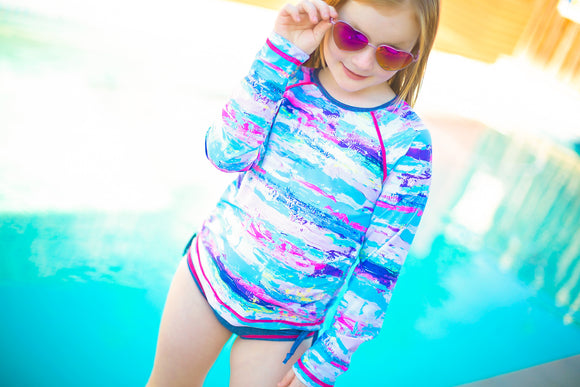By Marnie Durbidge from Horris & Deedle.
If you’ve sewn a few spandex items, chances are that you are starting to take note of a few different looking stitches in the BOO! group or on ready to wear clothing and have wondered “ohh how can I do that?”
The three main machines used for those of us who love to sew are the overlocker, the coverstitch, and a regular sewing machine. Each of these machines may be capable of some fancy stitches that allow you to add a little something extra to your items depending on which model you have and what it’s capable of. If you are wanting to attempt some more decorative sewing, your best friend in all of this is your MACHINE MANUAL as each machine is different and may require different settings to do the stitch.
FLATLOCK
The first stitch I want to discuss is the flatlock stitch. This is a really cool decorative stitch that is best used on seams that will not be under huge amounts of pressure when worn, such as the shoulder seam that attaches a raglan sleeve to a front piece, or a neckband.

A flatlock is a stitch sewn by an overlocker. You will need to consult your manual to see if your machine is capable of sewing one. Your manual should have a list of settings for you to set your machine to. I have two overlockers - both of them are capable of sewing a flatlock stitch. To sew the stitch on both of my machines, I need to remove the one of the needles and then follow the instructions for threading the machine. On one of my machines, the loopers are threaded as normal, but the needle is threaded a little differently to normal. On the other machine the threading process is normal but the settings are changed, which is why the manual is so important.
The flatlock stitch creates a decorative stitch on the right side, with a ladder stitch on the inside. The seam sits flat on the inside, making it a good option for people who are fussy with the feel of seams. I tend to use Maxi-Lock Stretch in my loopers when sewing a flatlock stitch as it creates a thicker look to the stitch. Naturally just to confuse you, in the below pictures I have used regular poly cotton.
Once you have got your machine settings right, here is how you sew the flatlock stitch, Place fabric pieces wrong sides together and sew. Yes this will feel a little odd.



Pull the fabric pieces gently apart to flatten the stitch.
Picture of inside showing the ladder stitch.
REVERSE OVERLOCK
To reverse overlock, place wrong sides facing and overlock with a short stitch length (around 2). When finished, top stitch the overlocked seam with a stretch stitch, long wide zig zag or triple stitch on the sewing machine.
Overlocked with Maxi-Lock Stretch in upper looper.
Top stitched with stretch stitch on sewing machine.
ROLLED HEM
A rolled hem is used as an alternative to finish a seam. It is also a stitch created by an overlocker. Once again, machine settings will differ from model to model and some machines will do it better than others. For rolled hems, the bottom of the hem gets rolled into a decorative stitch. It can create a lovely finish for swimwear ruffles, and while it’s not my preference, some love the look of it on a dress hem. Rolled hems can be a little tricky if your machine doesn’t feed the fabric through well and the fabric gets a little stretched as it is sewn. I would always recommend practicing this stitch on your machine on scraps of the material you plan to use to check and see if you like the look of it.

Once again, I love the look with Maxi-Lock Stretch in the loopers. Wooly nylon creates a similar effect, however remember that if the item will need to be ironed at some point, wooly nylon will not tolerate the heat from an iron and maxi lock stretch will.

REVERSE COVERSTITCH

Reverse coverstitch is a fantastic decorative stitch that can be used to create a stitch that is purely decorative, or add some stability to a seam that will be under lots of pressure, such as the crotch seam on leggings. As the name implies, reverse coverstitch is done exclusively by a coverstitch machine.

Whilst I don’t often sew with all three needles in with my coverstitch, for a decorative reverse coverstitch, I like it best with the third needle in. And I generally will use Maxi-Lock stretch in the looper.

Reverse coverstitch is simply just the same as coverstitching but you flip the fabric over, so that the right side faces down and the wrong side face up. I use it quite a bit when stitching pockets and on hems when I would like them to have a bit of pop and standout.

The other place to use reverse coverstitch is to sew down a seam to make it sit flat. I use this quite a bit on the crotch seam of leggings and waistbands.

The Boo! Shop sells a great range of Maxi-Lock threads including the Maxi-Lock Swirls range. With a bit of imagination, the swirls range can be used to make some really creative finishes to your garments. In the below pic I have used it on swimwear binding using reverse coverstitch to create a colourful stitch directly on the binding.


DECORATIVE STITCHES
Now what if you don’t have an overlocker that can sew a flatlock stitch, and a coverstitch machine will never be in the budget? Well it’s worth having a good look at your regular machine as many will have some cool decorative stitches that have quite a bit of stretch in them when sewn. My favourite of all of these is the honeycomb stitch, but there are loads you can use depending on your machine. My big tip for this is to use good quality thread and take the time to adjust the tension settings, stitch length, stitch width to make sure the thread doesn’t snap while you are sewing.
By using any of these stitches you can create some unique finishes to your garments.


Hopefully this has inspired you to have a play with your machines. I look forward to seeing all your fancy stitches in the Boo group!



Dorita Wessels
Thanks for explaining it so well!! That is so neatly done. May I ask what Overlocker you have used or is it done on a coverstitch?
Thank you
Carrolyn Outram
Thanks Marnie for your information you shared in this blog. You explained it so well and inspired me to want to use these decorative stitches. I’ve always admired your finishes on your garments.
Thanks for sharing.